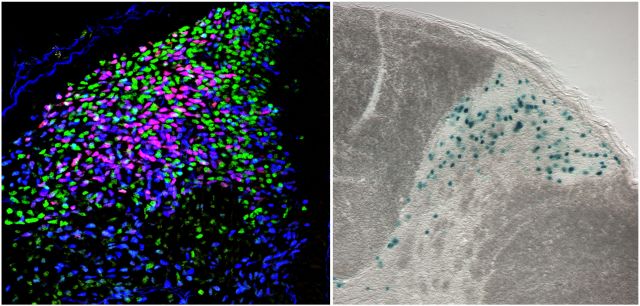Dorsal spinal cord development
The dorsal spinal cord processes information from nociceptive, mechanosensory and proprioceptive primary sensory neurons and relays it to higher brain centers. The cellular basis of these functions resides in a large number of interneurons that are located within distinct layers of the dorsal spinal cord. The molecular characteristics of these interneurons, as well as the mechanisms underlying their development are incompletely defined. In order to identify novel candidate genes, with putative functions in the development of the dorsal spinal cord, we have performed subtractive gene expression analyses with high-density oligonucleotide microarrays. By comparison of expression profiles of ventral and dorsal spinal cords, we identified genes that are enriched in the dorsal neural tube. Included among the differentially expressed genes are those with known functions in spinal cord development, as well as other genes with as yet unknown functions. Within this group of genes we have identified the homeodomain transcription factor Gbx1 and two C2H2 zincfinger transcription factors, Bcl11a and Bcl11b.

We recently demonstrated Gbx1 to be specifically expressed in a subset of Lbx1+ neurons in the dorsal spinal horn (John et al., 2005). Gbx1 identifies a previously uncharacterized population of late-born, Lhx1/5+, Pax2+ neurons, which undergo GABAergic differentiation during further development. The expression of Gbx1 suggests that it may control the development of a specific subset of GABAergic neurons in the dorsal spinal cord. We have generated loss-of-function mutations of the Gbx1 gene in mice and inserted an IRESnlsLacZ cassette into the genomic locus. This will allow us to determine the fate of Gbx1 mutant neurons during development of the dorsal spinal cord. Gbx1 and the closely related Gbx2 are co-expressed during the development of dorsal spinal neurons suggesting overlapping functions of both genes (John et al., 2005). Therefore, our analysis will include Gbx1/2 compound mutants.

Bcl11a and b are closely related C2H2 zincfinger transcription factors, which have previously been shown to be essential for lymphocyte development. Both genes are also expressed in the embryonic brain, spinal cord and peripheral nervous system. To analyze their functions during nervous system development we have generated CNS-specific conditional mouse mutants for the Bcl11a and b genes (collaboration with Neal Copeland, NCI Frederick). Conditional mutant animals die after birth, indicating that both genes serve, critical functions during nervous system development. Our phenotype analysis of the Bcl11a mutants indicates that the gene is critical for neuronal differentiation, and connectivity within the dorsal spinal horn (John et al., 2007).
